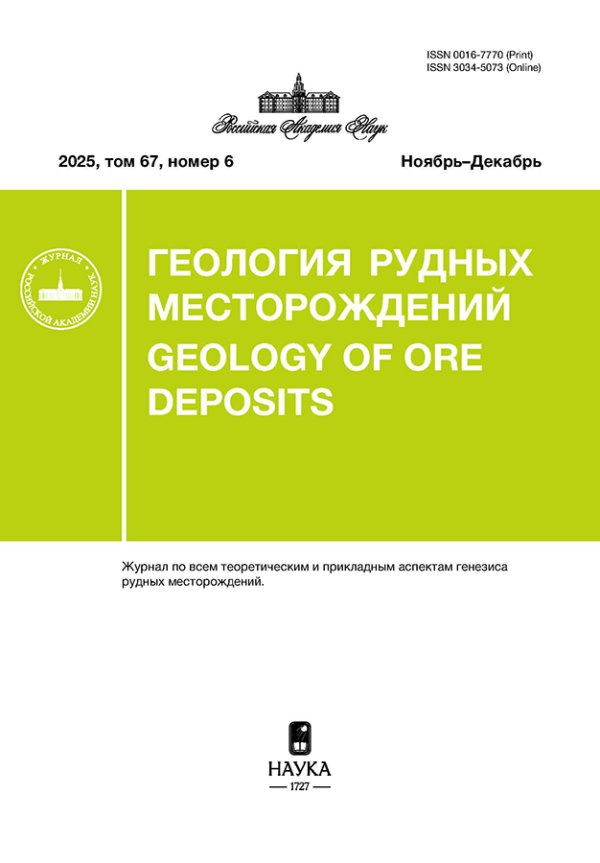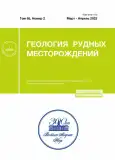Vol 65, No 2 (2023)
Articles
The Birkachan Epithermal Au–Ag Deposit in the Kedonsky Middle Paleozoic Volcanic Belt (Russian Northeast)
Abstract
The Birkachan deposit in the Middle Paleozoic Kedonsky Volcanic Belt (KVB) is unique in Northeast Russia for its stockwork epithermal Au–Ag ores. The deposit is located in the northeastern part of the Gurnik volcanotectonic depression, in the Kedonsky segment of the KVB. The deposit is localized in the lying side of a large sublatitudinal thrust fault, due to which it was overlain in the Jurassic–Early Cretaceous by allochthon rocks and, therefore, was slightly eroded, as evidenced by the preserved fragments of the argillisite cap. The ore-bearing Gurnik sequence is composed of felsic tuffs and lavas with intercalations of ignimbrites. The main ore-bearing zone of the Birkachan deposit is 4.5 km long and 200–300 m wide consists of several echelon-like vein zones of northeast strike, falling to the southeast at angles of 55°–70°. Most of the ore bodies are linear stockworks. Single, lenticular rich ore bodies represented by mineralized breccias have been found at deep horizons. In the section, the system of ore bodies of the Birkachan deposit forms a fan-shaped structure. The main textures of ores are vein-disseminated, breccia, and rhythmically banded. The ores are enriched in comparison with the upper continental crust in a rather narrow range of elements (Au, Ag, Sb, As, Mo, W, and Li) and are poor in rare-earth elements, among which light lanthanides predominate. The sulfide grade of ores is 0.1–0.5%. The vein minerals in ores are dominated by quartz, sericite, and siderite. Among the ore minerals, pyrite dominates, with fahlore, native gold and chalcopyrite, and minerals of the series acanthite → Se–acantite → naumannite, pearceite, and Se–pearceite being less common. The average fineness value of native gold is 643‰. The parameters of mineral-forming solutions correspond to typical medium-temperature fluids of epithermal low-sulfidized deposits: homogenization temperature of 93–291°С, salt concentration of 0.2–7.0 wt % eq. NaCl, and fluid density of 0.71–0.99 g/cm3. The main indicators of fluid composition are CO2/CH4 = 15.8–23.6, Na/K = 2.3–4.3, and K/Rb = 2007. The prospects for increasing the reserves of Au and Ag are associated with further study and exploration of the flanks and deep horizons of the deposit.
 111-137
111-137


SEARCH-ORIENTED TECHNIQUE OF THE NUMERICAL FORECASTING OF THE RARE-METAL PROXIMAL (NEAR DRIFT) PLACERS: EVIDENCE FROM THE LOVOZERO PLACER DISTRICT
Abstract
Rare metals (including rare earth metals) are significant raw materials which determine technical and scientific level of development of the industry; first of all – innovative technologies. An important source of rare metals can be a group of unique in genesis and mineral composition of loparite placers associated with the Lovozero massif of nepheline syenites (Cola peninsula). In the present work Within the Northern periphery of the Lovozero massif, which includes the Revda placer deposit, the authors have identified the main factors controlling the formation of proximal (near drift) rare-metal loparite placers. They have performed the formalization (numerical evaluation) of this factors and developed multiplicative indicators that reflect the placer potential of territories. To assess the effectiveness of the proposed technique based on the developed multiplicative coefficients, independent forecasts of placer metal content for the western and eastern placer-bearing areas of the Revda group of placers were calculated. For additional verification of the technique, the paper compares the obtained results with similar forecasts obtained using the methods of Linear Regression and Random forest of Regression trees. The developed method allows automating the process of forecasting of placer parameters, which is especially important for assessing deep-seated placers that are difficult to search and exploration and are not shown on the surface.
 138-151
138-151


Tectonophysical Forecasting Criteria of Vein Bodies Thicknesses in Deep Horizons of the Nadvigovaya Zone, Badran Ore Field, Republic of Sakha (Yakutia)
Abstract
A new technology of stress inversions is proposed on the basis of data of mute fracturing with measured amplitudes of dilative opening of fractures (tension shear), which are registered by mineralization (vein bodies). The involvement of a basic law of geomechanics of supercritical deformation, which determines the interrelation between amplitudes of shear deformations and deformations of transverse extension (dilatancy), allows us to link the amplitudes of opening of shear fractures with the level of Coulomb stresses. This approach can be used for a conjugated fracture system and fault zones with a system of similarly oriented fractures. Our algorithm and technology of stress calculation consist of consecutive analysis of a geometrical form and characteristic lineaments of density zone of fracture poles on the stereospheres and stress conditions of these fractures on Mohr’s diagram. The algorithm allows the calculation of the parameters of stress tensor both on the basis of graphical analysis on the stereonets and Mohr’s diagram and using a group of formulas. The algorithm is applied for the Nadvigovaya zone of the Badran deposit. The stress values are calculated for a fault area with measured fracturing, and a forecast for promising areas is given for a deeper fault part in areas with possible most intense dilatancy of fracture flow.
 152-178
152-178


Ore-Bearing Faults of Transpressional–Collisional Kinematics in the Verkhoyansk–Kolyma Fold Belt (Structural Consequences of the Geodynamic Model)
Abstract
The Verkhoyansk–Kolyma fold-thrust belt is an important metallogenic structure of northeastern Russia. Based on irregularly distributed gold mineralization within this belt two large ore-placer districts are distinguished: the Upper Indigirka district (UID) in the northwest and the Central Kolyma district (CKD) in the southeast. The gold grade in these areas is largely provided by a large fault structure—the ore-controlling Adycha–Taryn deep fault. Along the entire length, this fault changes its kinematic characteristics, from an overthrust reverse fault in the north to a strike-slip reverse fault (Tenka fault) in the south. Such a change of the fault kinematics laterally, in the principal ore-controlling structure, is reflected in the structure of specific ore-bearing faults in ore areas, as we have shown on the example of the Degdekan (CKD) and Drazhnoe (UID) deposits. In the Degdekan deposit, synthetic overthrust reverse faults, which control large-volume deposits of relatively poor ores, are ore-bearing, and, in the Drazhnoe deposit, opposite strike-slip faults contain small-size, superimposed rich ore bodies. The change of ore-bearing faults in different ore areas is explained by their position in the changing stress field that formed at different stages of geodynamic development: (1) associated with the collision of the Kolyma–Omolon superterrane and the Siberian craton and collision with the Alazeya arc (early ore mineralization of the Upper Indigirka ore district) and the Uda–Murgal arc (early disseminated pyrite mineralization of the Central Kolyma ore district) and (2) collision with the Chukchi microcontinent and re-activation of earlier faults (the main gold-sulfide-quartz mineralization of the Yana–Kolyma metallogenic belt)
 179-198
179-198












